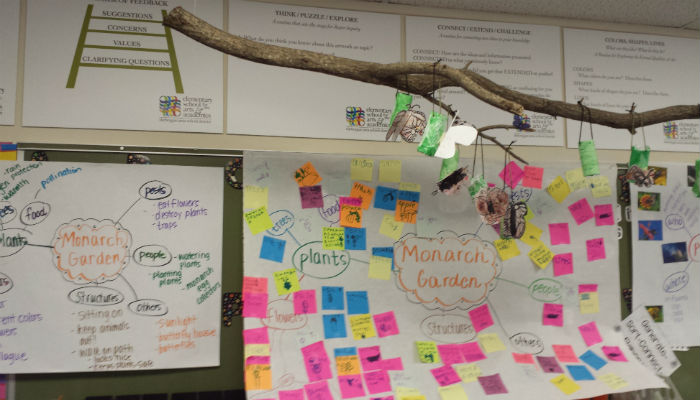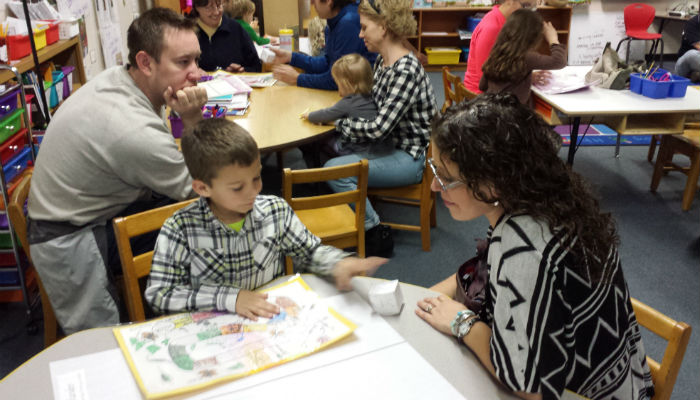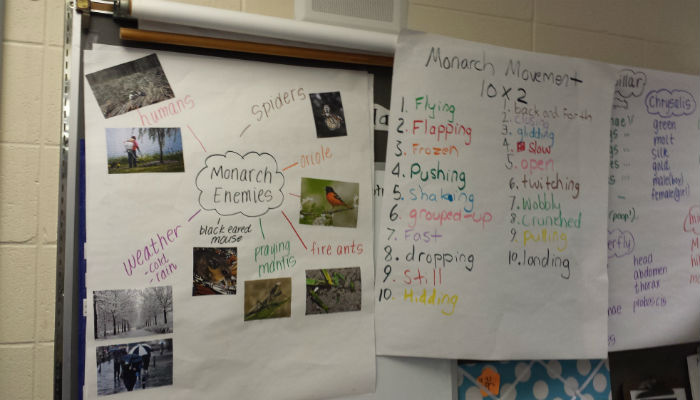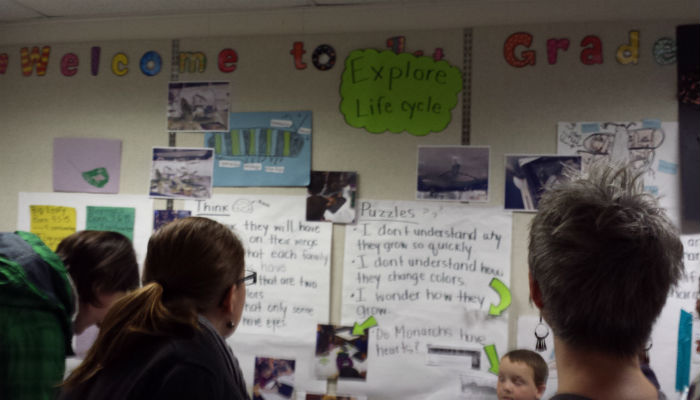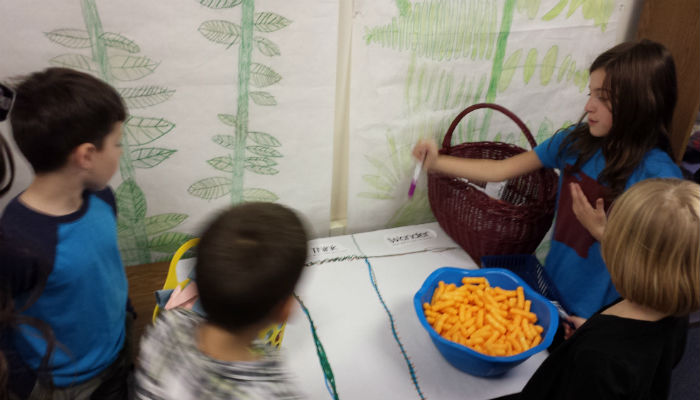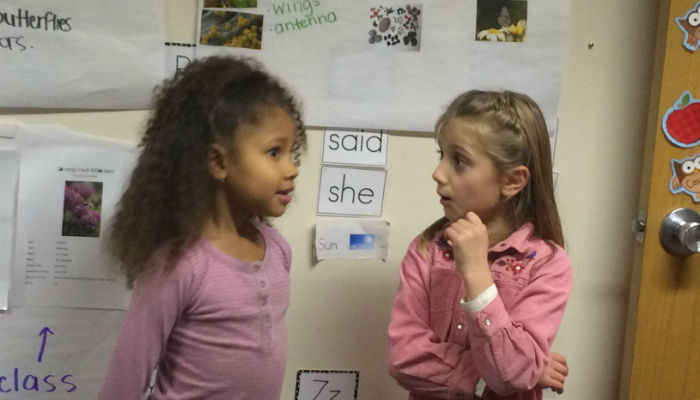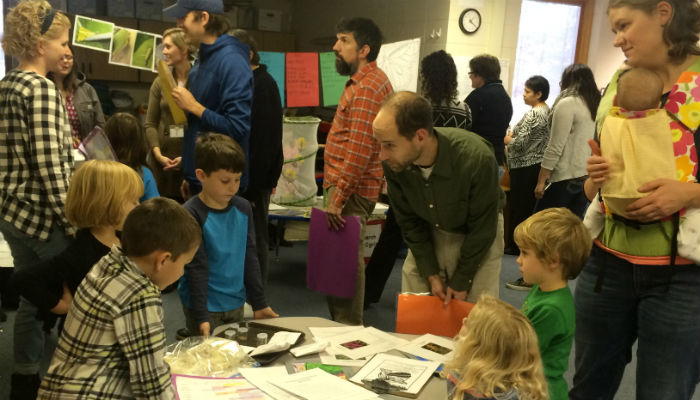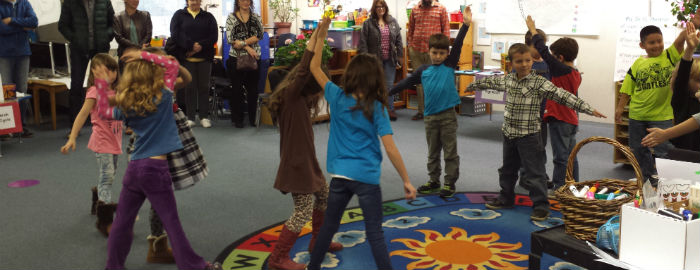
The first grade students of ESAA have spent the trimester exploring the question, “Why are monarch butterflies important?” Butterfly habitats, conservation, and the environment in general is an extremely relevant topic at the moment and also provides many opportunities to incorporate science, literacy, movement, and music.
Tuesday parents gathered for the first graders’ Exhibition of Learning at ESAA. The purpose of the EoL is for the students to discuss with families, teachers and other community members what they’ve uncovered about butterfly life and how we as humans are involved… for better and for worse. The afternoon included a movement piece, family game time, gallery walk and a musical performance.
The class interpreted, through movement, the life cycle of the butterfly, incorporating dance techniques like symmetrical formations and flocking, an improvisational form. These movements were intentional to symbolize the flight of butterflies. Stella and Ari mirrored each other’s movements, and when asked why responded, “because it is what butterflies do.”
While one class was interpreting the movements of the butterflies, the other class was next door playing board games with their families. These games were uniquely designed by each student and meant to put the player in the position of a monarch. Players must roll a special die to navigate over thousands of miles, avoiding mountains, escaping predators and finding food, from Sheboygan to their warm-weather roosting place in Mexico.

Student-created Monarch Migration board games allow players to navigate the boons and dangers of a butterfly's journey
There was a musical component as well. Groups created tableaus which corresponded to the story Waiting for Wings by Lois Ehlert. Then, both classes performed Flutter, Flutter, Butterfly. They learned the song in both English and Spanish because a monarch will spend half of her life in the United States or Canada and the other half in Mexico.
The heart of the EoL is the gallery walk, where panels of 2-3 students in groups sorted by topics like “Danger and Enemies” and “Life Cycle” discuss their learning specific to this area, what books and tools they used, and the products of their work, like their Learning Journals, charts, maps, and diagrams. Parents, teachers and other attendees were encouraged to ask questions about what they heard, and to participate in a See-Think-Wonder thinking routine about the topic. They directed onlookers to the charts of the thinking about butterfly issues they’ve done as a class since September.

Students incorporated their own thinking routines to present butterfly life cycles
But why are monarchs important? Why study them? What do they teach us?
The life and migration of monarchs makes an excellent tool to learn grade-appropriate science, like measuring, charting, graphing and mapping. “Since seasonal temperature changes are one of the factors that trigger a monarch's migration, we have been charting the high and low temperatures for each day.” Mrs. Beilke noted in her blog, “This is a really challenging task, but through teamwork and perseverance, our students found that this really challenging task was made more doable.” Additionally, the classes used real-life monarch tracking sites, like Journey North, to plot the course of actual butterfly sightings as they made their way through the United States. They made their own maps complete with a legend and color-coded migration patterns.
Throughout the trimester, students were continually putting themselves in the butterfly’s shoes, rather wings, to see the world as they do. How have monarchs adapted to their environment? What challenges do they overcome to survive? What are ways we as humans can help them on their journey? Why would some folks not want to help butterflies? How we understand that point of view?
While exploring these issues Mrs. McKeone reported in her blog, “To say the students are passionate about keeping the monarchs alive, worldwide, is an understatement. This thinking routine is not validating why humans are destroying the monarchs, but it helps students understand why a farmer wouldn't want their corn field overrun by milkweed and how tree farmers in Mexico continue to cut down the trees so they can support their families financially. It is all about a person's perspective.” They have learned, and care deeply about, a complex and relevant topic in the world and have learned to appreciate the many perspectives involved. The students who presented on the Dangers and Enemies of Monarchs explained to parents how humans may hurt and help butterflies.

Students invited their audience to See, Think, and Wonder about dangers facing butterflies
Another station explained the ways that humans can help butterflies on their journeys. To do what they could do to help, because they can, the class started planning a certified Butterfly Waystation on the school grounds to provide food and shelter to the migratory insects. Classes used tools like the Generate and Sort thinking routine to begin designs for their “dream” butterfly garden. Once they’d decided which “butterfly magnets” they would include in the garden, they planned out the garden according to bloom time and plant height. They drew detailed diagrams of the plants, and have now planted them for next year!

Students considered all factors of the "dream" butterfly garden on a generate and sort thinking routine
The Exhibition of Learning was a wonderful showcase of the learning this trimester and showed how movement and music can be integrated to extend understanding of a complex topic. It also invited parents and guests to engage the students and ask questions about what they have learned. As Mrs. McKeone pointed out, it’s “all about a person’s perspective.” Now these ESAA first graders have many new ones to consider and take with them, all because of a butterfly’s journey. At the end of the month, the first graders will be presenting their individual projects for Presentations of Learning, where each student will revisit one of these butterfly issues.

